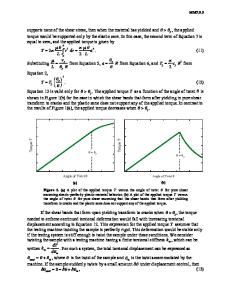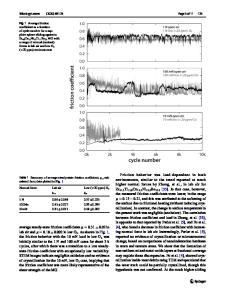Mechanical properties of iron-based bulk metallic glasses
- PDF / 288,515 Bytes
- 8 Pages / 585 x 783 pts Page_size
- 78 Downloads / 339 Views
Gary J. Shiflet Department of Materials Science and Engineering, University of Virginia, Charlottesville, Virginia 22904-4745 (Received 1 June 2006; accepted 18 September 2006)
Iron-based bulk metallic glasses (BMGs) are characterized by high fracture strengths and elastic moduli, with some exhibiting fracture strengths near 4 GPa, 2–3 times those of conventional high-strength steels. Among the Fe-based BMGs, the non-ferromagnetic ones, designated “non-ferromagnetic amorphous steel alloys” by two of the present authors [S.J. Poon et al.: Appl. Phys. Lett. 83, 1131 (2003)], have glass-forming ability high enough to form single-phase glassy rods with diameters reaching 16 mm. Fe-based BMGs designed for structural applications must exhibit some plasticity under compression. However, the role of alloy composition on plastic and brittle failures in metallic glasses is largely unknown. In view of a recently observed correlation that exists between plasticity and Poisson’s ratio for BMGs, compositional effects on plasticity and elastic properties in amorphous steels were investigated. For the new amorphous steels, fracture strengths as high as 4.4 GPa and plastic strains reaching ∼0.8% were measured. Plastic failure instead of brittle failure was observed as the Poisson’s ratio approached 0.32 from below. Investigation of the relationship between the elastic moduli of the alloys and those of the alloying elements revealed that interatomic interactions in addition to the elastic moduli of the alloying elements must be considered in designing ductile Fe-based BMGs. The prospects for attaining high fracture toughness in Fe-based BMGs are discussed in this article.
I. INTRODUCTION
The large number of bulk metallic glass (BMG) alloy systems discovered to date has given rise to the prospect for inexpensive structural BMGs that exhibit superior properties such as high strength and hardness, as well as high corrosion and wear resistance. Considering the low cost of iron, it is not surprising that a variety of ironbased BMGs are being investigated as future structural metals.1–8 A brief review of different types of Fe-based BMGs will be given in the next section. Recently, several nonferromagnetic Fe-based BMGs, also known as amorphous steels,1–3,8 have been found to have fracture strengths near 4 GPa. However, these Fe–Mn–Cr–C–B amorphous steels, created at the University of Virginia,1 and subsequently developed by several groups in forming BMGs with thicknesses that exceed 10 mm, are brittle.2–4,9 Meanwhile, a number of recently reported Fe-based BMGs designed for soft magnetic applications also show high fracture strengths of 2.8–4.2 GPa, toa)
Address all correspondence to this author. e-mail: [email protected] DOI: 10.1557/JMR.2007.0036 344
J. Mater. Res., Vol. 22, No. 2, Feb 2007
gether with small compressive yield strains of 0.1– 0.4%.5–7 Unfortunately, these findings do not offer sufficient information about how the composition can influence the deformation behavior of Fe-based BMGs. From an application standpoint, s
Data Loading...











